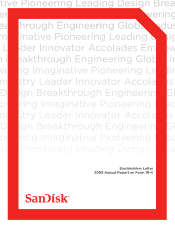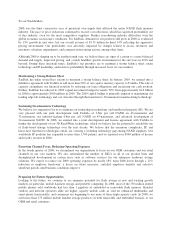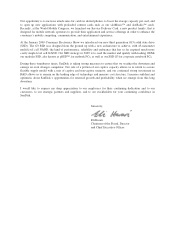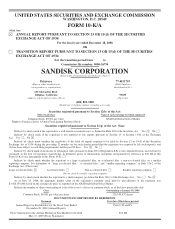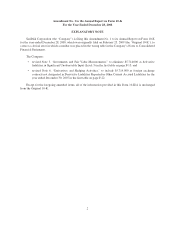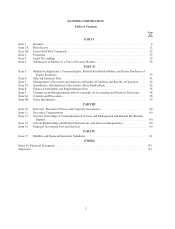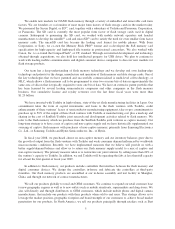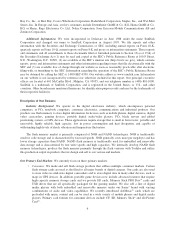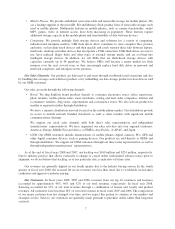SanDisk 2008 Annual Report Download - page 9
Download and view the complete annual report
Please find page 9 of the 2008 SanDisk annual report below. You can navigate through the pages in the report by either clicking on the pages listed below, or by using the keyword search tool below to find specific information within the annual report.We enable new markets for NAND flash memory through a variety of embedded and removable card form
factors. We are founders or co-founders of most major form factors of flash storage cards in the market today.
We pioneered the Secure Digital, or SD™, card, together with a subsidiary of Toshiba and Panasonic Corporation,
or Panasonic. The SD card is currently the most popular form factor of flash storage cards used in digital
cameras. Subsequent to pioneering the SD card, we worked with mobile network operators and handset
manufacturers to develop the miniSD™card and microSD™card to satisfy the need for even smaller form factor
memory cards. The microSD card has become the leading card format for mobile phones. With Sony
Corporation, or Sony, we co-own the Memory Stick PRO™format and co-developed the SxS memory card
specification for high-capacity and high-speed file transfer in professional camcorders. We also worked with
Canon, Inc. to co-found the CompactFlash®, or CF, standard. Through our internal development and technology
obtained through acquisitions, we also hold key intellectual property for USB drives. We plan to continue to
work with leading mobile communications and digital consumer device companies to discover new markets for
flash storage products.
Our team has a deep understanding of flash memory technology and we develop and own leading-edge
technology and patents for the design, manufacture and operation of flash memory and data storage cards. One of
the key technologies that we have patented and successfully commercialized is multi-level cell technology, or
MLC, which allows a flash memory cell to be programmed to store two or more bits of data in approximately the
same area of silicon that is typically required to store one bit of data. We have an extensive patent portfolio that
has been licensed by several leading semiconductor companies and other companies in the flash memory
business. Our cumulative license and royalty revenues over the last three fiscal years were more than
$1.29 billion.
We have invested with Toshiba in high volume, state-of-the-art flash manufacturing facilities in Japan. Our
commitment takes the form of capital investments and loans to the flash ventures with Toshiba, credit
enhancements of these ventures’ leases of semiconductor manufacturing equipment, take-or-pay commitments to
purchase up to 50% of the output of these flash ventures with Toshiba at manufacturing cost plus a mark-up and
sharing in the cost of SanDisk-Toshiba joint research and development activities related to flash memory. We
refer to the flash memory which we purchase from the SanDisk-Toshiba joint ventures as captive memory. Our
long-term strategy is to have a mix of captive and non-captive supply and we have historically supplemented our
sourcing of captive flash memory with purchases of non-captive memory, primarily from Samsung Electronics
Co., Ltd., or Samsung, Toshiba and Hynix Semiconductor, Inc., or Hynix.
In fiscal year 2008, we purchased almost no non-captive memory and our inventory balances grew due to
the growth of output from the flash ventures with Toshiba and weak consumer demand influenced by worldwide
macroeconomic conditions. Recently, we have implemented measures that we believe will provide us with a
better supply/demand balance and allow us to return our flash memory supply model to a mix of captive and
non-captive memory. The primary measure taken is to restructure our joint ventures by selling more than 20% of
the venture’s capacity to Toshiba. In addition, we and Toshiba will be operating the fabs at less than full capacity
for at least the first quarter of fiscal year 2009.
In addition to flash memory, our products include controllers that interface between the flash memory and
digital consumer devices. We design the controllers in-house and fabricate the controllers at third-party
foundries. Our flash memory products are assembled at our in-house assembly and test facility in Shanghai,
China, and through our network of contract manufacturers.
We sell our products globally to retail and OEM customers. We continue to expand our retail customer base
to new geographic regions as well as to new outlets such as mobile storefronts, supermarkets and drug stores. We
also sell directly and through distributors to OEM customers, which include mobile phone and digital camera
manufacturers, that include our products with their products when sold to end users. This strategy allows us to
leverage the market position, geographic footprint and brand strength of our customers to achieve broad market
penetration for our products. In North America, we sell our products principally through retailers such as Best
5

